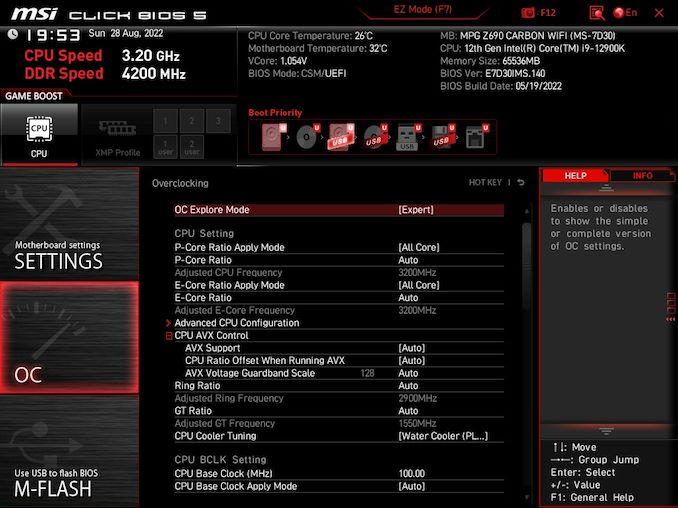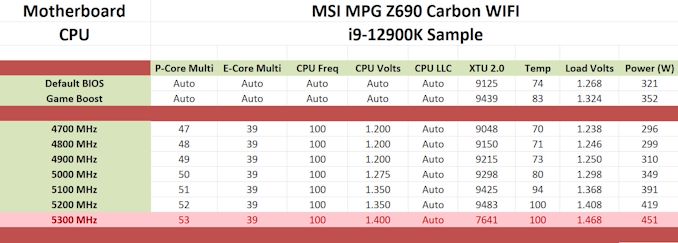The MSI MPG Z690 Carbon WIFI (DDR5) Motherboard Review: A Decent Mid-Ranged Z690
by Gavin Bonshor on September 8, 2022 8:00 AM ESTOverclocking
When it comes to overclocking on Intel's 12th generation processors, Alder Lake has a new yet important variable to consider. This is because not all of its cores are equal. Intel's latest Alder Lake processors feature a hybrid design with P-cores (performance) and E-cores (efficiency). Focusing on the Core i9-12900K, it has 8 P-Cores, 8 E-cores, and 24 threads in total. While Hyperthreading isn't a new technology, the hybrid nature of Alder Lake combining two different types of CPU core is. The basic idea is that the P-cores do much of the front-loaded heavy lifting, the grunt work, so to speak, while the E-cores assist in the background with high-threaded workloads with a much lower overall power draw than the P-cores.
Having personally taken some time to investigate overclocking ability with the Core i9-12900K before diving into motherboard reviews, I found that the P-cores offer much more in terms of performance. In contrast, the E-cores don't have as much headroom or scalability as the P-cores. Fundamentally when paired with a Z690 motherboard, both the P-core and E-cores are unlocked. This gives two areas for users to consider when it comes to overclocking.
Another point of note when overclocking with Alder Lake, like with 11th gen and 10th gen, performance out of the box on both sets of cores are squeezed out via turbo, e.g., the P-Core Turbo on the Core i9-12900K is 5.2 GHz, while the E-Core turbo is 3.9 GHz. Make no mistake about it, Alder Lake is power-hungry, even more so from personal experience when overclocking than was the case with 11th gen Rocket Lake. This means adequate power being made available from a reliable and quality power supply is needed, as well as good quality and premium cooling such as AIOs, or even custom water cooling.
Experience with the MSI MPG Z690 Carbon WIFI
Looking at the overclocking functionality of the MSI MPG Z690 Carbon WIFI, all of the overclocking options can be found within the OC section of the Advanced mode in the firmware. MSI offers plenty of CPU overclocking options, including separate P-Core and E-Core ratio multiplier controls, CPU AVX ratio offsetting, as well as CPU Ring Ratio, and integrated graphics ratio multipliers. In terms of voltages, MSI also includes an extensive list of voltages including CPU VCore, iGPU (CPU GT) voltages, as well as individual P-Core and E-Core VCore voltage options.
When it comes to memory overclocking, MSI also provides plenty of options for overclocking the frequency, adjusting Intel's Geared memory mode in either 1:1, 1:2, or 1:4 ratios, as well as lots of primary, secondary, and tertiary latencies to customize. For fine-tuning of the board's power profiling, MSI includes multiple levels of loadline calibration (LLC) profiles, with levels that can increase or decrease CPU VCore VDroop depending on the complexity and intensity of the workload. It should be noted that Level 4 is typically the sweet spot for balancing CPU VCore voltage, power, and stability while ensuring less frequent/softer spikes in voltage.
Overall the MSI Click BIOS 5 firmware has pretty much everything a typical user could need to overclock their Intel 12th Gen Core processor, memory kit, and even integrated graphics on supported processors.
Overclocking Methodology
Our overclocking methodology is as follows. We select the automatic overclock options and test for stability with the Intel XTU 2.0 benchmark and Prime95 to simulate high-end workloads. These stability tests aim to catch any immediate causes for memory or CPU errors.
For manual overclocks, based on the information gathered from the previous testing, start off at a nominal voltage and CPU multiplier, and the multiplier is increased until the stability tests are failed. The CPU voltage is increased gradually until the stability tests are passed. The process is repeated until the motherboard reduces the multiplier automatically (due to safety protocol) or the CPU temperature reaches a stupidly high level (105ºC+). Our testbed is not in a case, which should push overclocks higher with fresher (cooler) air.
Note: For the purposes of overclocking in our Z690 reviews, we will only be focusing on the P-cores (performance) as these simply scale better. The E-core (efficiency) will subsequently be set at 3.9 GHz throughout the entirety of our Z690 motherboard reviews.
Overclocking Results
Focusing on the overclocking performance using our Core i9-12900K with the MSI MPG Z690 Carbon WIFI, we observed pretty decent performance on the whole. Using the board at default settings as our baseline, MSI's Game Boost profile does improve performance somewhat, with very economical power (if you can consider 352 W economical) consumption when compared to default settings. The caveat to using Game Boost is it does run on the hot side, as we reported temperatures of 83°C with our premium 360 mm AIO cooler; this is still well within the rated specifications, however.
Switching to manual overclocking, and we managed to achieve a maximum stable overclock of 5.2 GHz on the P-Cores of our Core i9-12900K processor at 1.35 V. This translated to a maximum load VCore of 1.408 which is a considerable amount of VDroop, despite using the automatic option on the LLC profile selector menu. This also hit 100C and did thermal throttle a little, but not as much as 5.3 GHz at 1.40 V, which did run stable but was not economical from a power consumption (over 450 W) nor a heat point of view. Going from 4.7 GHz to 5.1 GHz, we saw an incremental increase in XTU 2.0 performance, with pretty consistent and tight VDroop all-around.












17 Comments
View All Comments
worldsenvy - Sunday, September 11, 2022 - link
It would be more apt to compare it to if they made the price of eggs $24 for a dozen. 390 for a Mid range board is ridiculous.PeachNCream - Thursday, September 8, 2022 - link
Agreed that PC component prices are utterly absurd at the moment. Some of the cost is tied up in inflation but there is also cost passed onto consumers through the addition of non-functional additions like plastic coverings and lighting. The establishment of various chipset categories (remember when there was basically one chipset to support a CPU generation and it had all the features instead of a set of progressively more stripped down alternatives that now supposedly justify the higher component cost of less feature-limited motherboards?) has done a lot to build a market segment that snags the extra dollars once lost to tinkerers and overclockers that were actually getting extra performance for free instead of pay a price premium for unlocked parts that basically roll the price of overclocking performance gains into said parts.Probably the best thing you can do to shut this sort of garbage from OEMs down is to buy a good enough for work/communication laptop - something lower cost - and either work within its capabilities to play games it can run well. There are lots and lots of games that do not need anything beyond a bottom feeder budget laptop with a garbo iGPU that can keep you amused for the rest of your life. Alternatively, you can always use the cost of a motherboard like this plus a few extra dollars to buy a console. The money you save in additional components can go into the somewhat higher cost of the games on a closed console platform and still buy you a LOT of amusement for the same total price as a desktop gaming PC without any software.
Basically, at this point, gaming PCs are not very cost-effective purchases on just hardware alone. Nevermind the power demands and, if you live in a warm climate, the secondary power costs incurred moving their waste heat out of your home. It's a no-brainer to just change how you entertain yourself a little bit to move the needle to more practical alternatives and you ultimately don't really have to compromise on the end goal of killing time in a fun way either.
meacupla - Thursday, September 8, 2022 - link
List of things making mobos more expensive these days:PCIe 5.0 capable traces
DDR5 capable traces
VRM design that can handle overclocked 12900K
Copper prices have gone up
Supply chain issues
Tariffs
Inflation
That and this mobo is not mid-range. It is high end. It's not a halo product, but it is packed with above average features. IDK why anandtech insists on calling it "mid-ranged", when it's price point is 5th from the top in MSI's intel 12th gen lineup.
MSI Z690 Tomahawk Wifi, and Z690-A Wifi are significantly cheaper.
timecop1818 - Saturday, September 10, 2022 - link
> DDR5 capable tracesThe price difference between PRO-A Z690 and PRO-A Z690 DDR5 is like $15.
meacupla - Thursday, September 8, 2022 - link
Those memory overclock speeds from the corsair kit are abysmal.Is the corsair kit using Micron dies? because I am getting a lot of info that those are trash and can barely hit 5400.
You really need to get your hands on some SK Hynix or Samsung die DDR5, preferably SK Hynix, to see what the mobo is really capable of.
sonny73n - Saturday, September 10, 2022 - link
18 true phase for CPU VRM is way overkilled. Back in Sandy Bridge day, 6-8 true phase considered premium and we could overclock the hell out of the chip. Nowadays processors get heat up too fast, I'd rather leave them on stock clock or underclock in case of GPU.They should instead implement a better audio design with a high end DAC (ESS or AKM comes to mind) and a good headphones amp to drive 600 Ohms headphones.
RestChem - Sunday, September 18, 2022 - link
What kinda baffles me is how quickly all the manufacturers spat out not just a couple but five or more Z690 boards, then for good measure additional some SKUs with tacit DDR5 support (though in all cases I've bothered to check so far the claimed support for dual-rank configs is limited to about five kits total from reference up to 6000) but all their top-end stuff is loused up with WiFi and blinky dragons and various, often questionable airguide/heatsink/EMF-shielding combos as though that's what's going to sell a board to hardcore OCers. Who the hell buys a $500-1000 mobo and connects through WiFi, or would want that on-board? Why not lots of room, great cooling, great unadorned boards and, I don't know, some free GPU braces? How do you sell this thing against the Pro Z690-A at a bit over half the price?